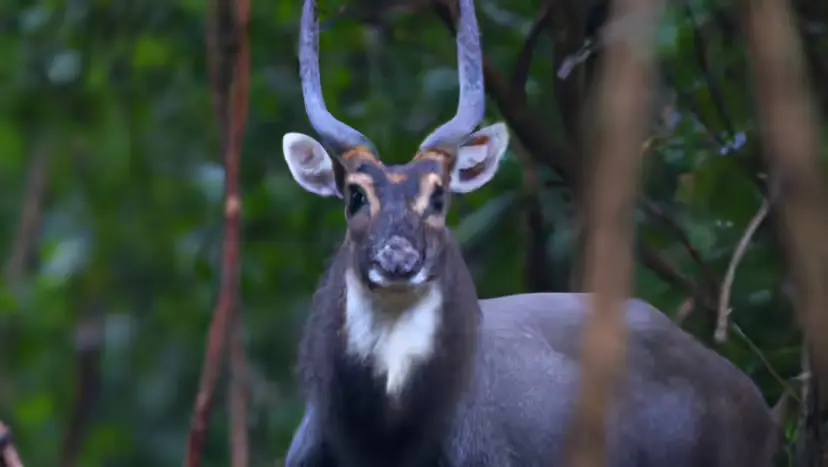Status: Critically Endangered (CR); best estimates put fewer than 100 individuals left in the wild, and declining.
Range: Restricted to the Annamite Mountains on the Vietnam–Laos border; distribution is highly fragmented.
Main threats: A widespread snaring crisis, illegal hunting and trade, habitat degradation, and major data gaps on its ecology.
Conservation now relies on camera traps, dung DNA/forensic analyses, community interviews and cross-border patrols; there is no captive population and no proven breeding protocol.

Scientific name: Pseudoryx nghetinhensis (family Bovidae; sole species in the genus Pseudoryx).
Appearance: Both sexes bear long, nearly parallel horns with fine ridging; bold white facial markings; body size between antelope and small wild cattle. Though antelope-like, phylogenetically closer to wild cattle.
Ecological role: A flagship and umbrella species for high-elevation evergreen forests—protecting saola helps safeguard entire Annamite forest food webs.
In 1992, surveys around Vu Quang Nature Reserve (Vietnam) revealed horn trophies unlike any known species. Confirmed soon after, saola became one of the century’s most spectacular mammal discoveries. The last unequivocal wild record was in 2013—a measure of how elusive it is.
Geography: Discrete pockets across the Annamites (Vietnam’s Nghe An–Ha Tinh–Quang Binh; central Laos such as Bolikhamxay).
Elevation & habitat: ~300–1,200+ m evergreen forests, river valleys, mist zones, and dense understory near water and natural mineral licks.
Behavior (inferred): Likely crepuscular, solitary or in pairs/small groups; browsers of leaves, shoots, vines, fruits; extremely disturbance-sensitive.
Core life-history data—breeding season, gestation, home-range size, juvenile survival—remain largely unknown, complicating management.
Snares everywhere
Steel-wire and nylon snares—set for civets, muntjacs, and wild pigs—indiscriminately catch saola. Without relentless snare removal, intact forests become “empty forests”.
Habitat degradation & fragmentation
Feeder roads, edge logging, mining, hydropower, and agriculture carve forests into islands, block gene flow, and push saola into risky edges with dogs and snares.
Data poverty & weak awareness
Sparse, scattered detections make it hard to prioritize protection units; limited public understanding undermines sustained support.
Systematic camera-trap grids along game trails, ridgelines, licks, and stream crossings.
Dung/hair DNA & isotope work for species ID, sexing, relatedness, and diet clues.
Local knowledge & detection dogs to speed snare removal and sample searches.
Environmental DNA (eDNA) pilots in streams/licks for low-impact presence/absence mapping.
There are no saola in captivity and no proven ex-situ breeding. For now, in-situ protection is the only realistic path.
Institutionalized snare-sweeps with “high-risk grids” for priority clearing.
Penalties with bite: strengthen sanctions for possession/transport of snares and bushmeat; coordinate cross-border enforcement.
Choke off trade chains: target the forest–village–market–border pipeline.
Use remote sensing + ground truthing to upgrade core sites (e.g., around mineral licks, low-disturbance evergreen blocks).
Restore pinch points (road crossings, edge cuts) with wildlife passages and functional buffers.
Pay-for-performance (e.g., snare-free villages, elite patrol teams).
Alternative income: non-timber forest products, honey, cinnamon/resins, handicrafts; low-impact ecotourism (no wildlife disturbance).
Demand reduction: urban campaigns against bushmeat and “forest delicacies.”
Integrate camera/eDNA/interviews to update Priority Units (PUs).
Use independent data repositories and third-party evaluation to keep monitoring transparent and funding effective.
While in-situ is paramount, experts continue to debate a safety-net population (assurance colony):
If a viable, healthy rescue becomes available, should a small, carefully managed assurance group be attempted?
Any move demands ethical review, genetic planning, capture risk assessment, and facility readiness. Even without action, protocols should exist before crisis strikes.
Back frontline groups doing year-round snare removal, monitoring, and community projects in the Annamites.
Say no to bushmeat/illegal wildlife; report sale of snares or wild meat.
Travel responsibly in Vietnam/Laos; choose operators that avoid wildlife disturbance and never buy animal parts/trophies.
Share accurate info—promote science-based saola content; push back against clickbait/myths.
Watch supply chains—support zero-deforestation wood, and ensure infrastructure/agriculture avoid high conservation value (HCV) forests.
How many saola are left?
Best estimate: fewer than 100 in the wild, with high uncertainty—hence the rarity of detections.
What habitat do they prefer?
Dense, wet evergreen forest with water and mineral licks, minimal human disturbance.
Why not capture some to breed?
There are no captive individuals and no proven protocols. Capture is risky and could harm the last remaining animals; without strong evidence and facilities, it’s not prudent.
What’s the biggest bottleneck?
The snaring crisis, plus insufficient data and unstable funding. Snare removal and enforcement are labor-intensive and must be sustained.
Saola are real—living, barely, in the clouded ridges of the Annamites. Remove one snare, secure one forest patch, add one solid data point—each can tip the balance. Saving the “Asian unicorn” also means saving the soul of Southeast Asia’s mountain rainforests. Act now; there is still time.
animal tags: Saola
We created this article in conjunction with AI technology, then made sure it was fact-checked and edited by a Animals Top editor.